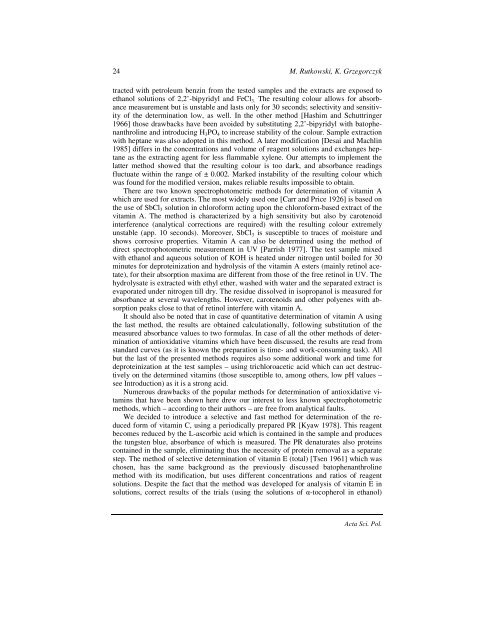pdf 2_3_2007 - Technologia Alimentaria
pdf 2_3_2007 - Technologia Alimentaria
pdf 2_3_2007 - Technologia Alimentaria
You also want an ePaper? Increase the reach of your titles
YUMPU automatically turns print PDFs into web optimized ePapers that Google loves.
24<br />
M. Rutkowski, K. Grzegorczyk<br />
tracted with petroleum benzin from the tested samples and the extracts are exposed to<br />
ethanol solutions of 2,2’-bipyridyl and FeCl 3. The resulting colour allows for absorbance<br />
measurement but is unstable and lasts only for 30 seconds; selectivity and sensitivity<br />
of the determination low, as well. In the other method [Hashim and Schuttringer<br />
1966] those drawbacks have been avoided by substituting 2,2’-bipyridyl with batophenanthroline<br />
and introducing H 3PO 4 to increase stability of the colour. Sample extraction<br />
with heptane was also adopted in this method. A later modification [Desai and Machlin<br />
1985] differs in the concentrations and volume of reagent solutions and exchanges heptane<br />
as the extracting agent for less flammable xylene. Our attempts to implement the<br />
latter method showed that the resulting colour is too dark, and absorbance readings<br />
fluctuate within the range of ± 0.002. Marked instability of the resulting colour which<br />
was found for the modified version, makes reliable results impossible to obtain.<br />
There are two known spectrophotometric methods for determination of vitamin A<br />
which are used for extracts. The most widely used one [Carr and Price 1926] is based on<br />
the use of SbCl3 solution in chloroform acting upon the chloroform-based extract of the<br />
vitamin A. The method is characterized by a high sensitivity but also by carotenoid<br />
interference (analytical corrections are required) with the resulting colour extremely<br />
unstable (app. 10 seconds). Moreover, SbCl 3 is susceptible to traces of moisture and<br />
shows corrosive properties. Vitamin A can also be determined using the method of<br />
direct spectrophotometric measurement in UV [Parrish 1977]. The test sample mixed<br />
with ethanol and aqueous solution of KOH is heated under nitrogen until boiled for 30<br />
minutes for deproteinization and hydrolysis of the vitamin A esters (mainly retinol acetate),<br />
for their absorption maxima are different from those of the free retinol in UV. The<br />
hydrolysate is extracted with ethyl ether, washed with water and the separated extract is<br />
evaporated under nitrogen till dry. The residue dissolved in isopropanol is measured for<br />
absorbance at several wavelengths. However, carotenoids and other polyenes with absorption<br />
peaks close to that of retinol interfere with vitamin A.<br />
It should also be noted that in case of quantitative determination of vitamin A using<br />
the last method, the results are obtained calculationally, following substitution of the<br />
measured absorbance values to two formulas. In case of all the other methods of determination<br />
of antioxidative vitamins which have been discussed, the results are read from<br />
standard curves (as it is known the preparation is time- and work-consuming task). All<br />
but the last of the presented methods requires also some additional work and time for<br />
deproteinization at the test samples – using trichloroacetic acid which can act destructively<br />
on the determined vitamins (those susceptible to, among others, low pH values –<br />
see Introduction) as it is a strong acid.<br />
Numerous drawbacks of the popular methods for determination of antioxidative vitamins<br />
that have been shown here drew our interest to less known spectrophotometric<br />
methods, which – according to their authors – are free from analytical faults.<br />
We decided to introduce a selective and fast method for determination of the reduced<br />
form of vitamin C, using a periodically prepared PR [Kyaw 1978]. This reagent<br />
becomes reduced by the L-ascorbic acid which is contained in the sample and produces<br />
the tungsten blue, absorbance of which is measured. The PR denaturates also proteins<br />
contained in the sample, eliminating thus the necessity of protein removal as a separate<br />
step. The method of selective determination of vitamin E (total) [Tsen 1961] which was<br />
chosen, has the same background as the previously discussed batophenanthroline<br />
method with its modification, but uses different concentrations and ratios of reagent<br />
solutions. Despite the fact that the method was developed for analysis of vitamin E in<br />
solutions, correct results of the trials (using the solutions of α-tocopherol in ethanol)<br />
Acta Sci. Pol.










